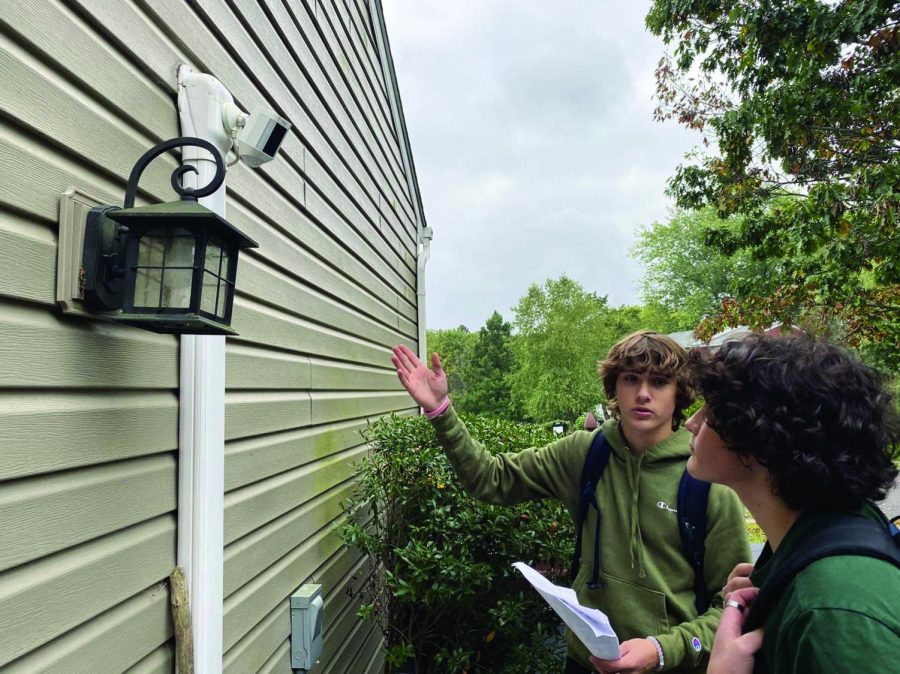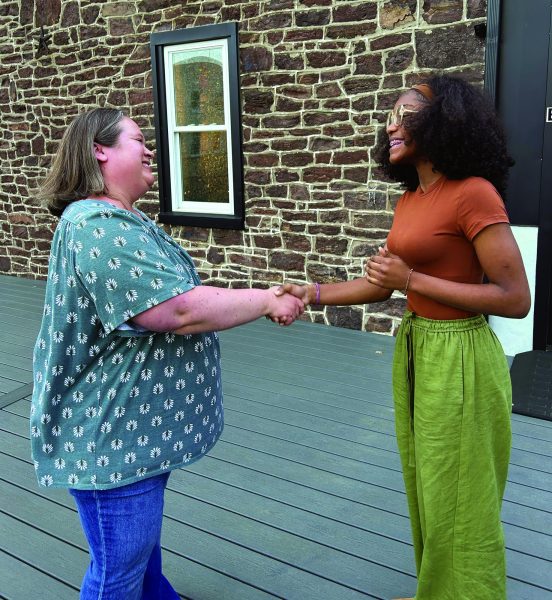Science teachers shed light on light pollution
Because of modern developments, light pollution has become an issue for the health of the night sky and for organisms who rely on natural and unpolluted darkness.
Arrowhead photo by Oliver Milles
Environmental investigation…Examining motion sense lighting, sophomore Jaden Knize explains to sophomore Keiran Maldonado the importance of motion sense lighting. The IDA reccomends using motion sense lighting to limit how long outdoor lights are on.
By using unnecessary and unnatural lighting, the human population decreases visibility of the unobscured night sky, which affects migration patterns, animal and human health, and viewing conditions of the night sky.
According to science teacher Kristi Grandy, light pollution is artificial light that is related to human practices that obscures the natural night sky.
It is a problem derived from modern practices following new development from humans. “A hundred years ago we didn’t have electricity so you had a nice view of the sky after sundown,” Grandy said. “Now we have headlights, lamp posts, lights from shopping centers, so it’s rare that we see a true dark sky.”
Viewing the night sky has proven to be more difficult. “I grew up in this area, in Lederach, and I used to be able to see tons of stars. Now, I’m really not seeing as many stars anymore,” science teacher Kelly McDonough said.
Light pollution varies from area to area.
“In a more urban area, where the lights are pretty bright, you might be able to see the moon, and the brightest stars,” Grandy said, “but most other stars are small and dim so you really need a true dark sky to make them out.”
According to Grandy, light helps illuminate dust particles in the air so, if fog is present, there’s a “reflectivity aspect” that further decreases viewing conditions.
The atmosphere is also made of gasses. This means that light is naturally refracting and making viewing conditions even poorer.
Daylight hours can be extended by lights further adding to the light pollution issue.
“It allows us to extend our daylight, our hours of work and activity and in our society especially now, we really need that to squeeze things onto the day,” Grandy said.
Light can often be necessary for people to do certain things, but unnecessary usage of light can be harmful to the environment.
“People have beautiful homes with spotlights pointing upwards and illuminating their house,” Grandy said. “It’s kind of cool, but it’s not really serving a purpose other than a visual aesthetic.”
The International Dark-Sky Association recommends using motion sensing lights rather than constant light and switching to warmer lighting instead of LED lighting.
These unnatural light sources have various negative impacts on the surrounding environment and the organisms in it.
“Birds will often migrate at night and if there’s all this light pollution then they can’t really tell the landmarks that they need to look at because of the light pollution,” science teacher Kim Wilson said.
Various other animals are also affected by light pollution including turtles.
“Turtles can’t find their way to the ocean because they are confused,” Wilson said. “If they can’t see the stars then they can’t navigate.”
According to Wilson people have been making a conscious effort to take lights off of beaches to help reduce that.
Insects and other bugs are also affected, which can have severe consequences to certain ecosystem’s food webs.
“If we’re losing bugs because they are flying onto lights at night, then they’re not doing what they’re supposed to be doing, like reproducing, or pollinating plants, or even being a food source for birds,” Wilson said.
If the insect population is affected, then oftentimes, the rest of the population is as well. “Everything that impacts a habitat ultimately affects the whole ecosystem,” Wilson said





